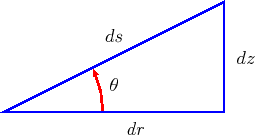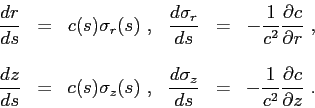Cilindrical symmetry (two-dimensional case)
In a system with cilindrical symmetry (see Fig.2.1) the Eikonal equation follows directly
from Eq.(2.18) and Eq.(2.19),
by replacing  with
with  and nullifying any derivative along
and nullifying any derivative along  :
:
 |
(2.21) |
under this conditions the system Eq.(2.16) becomes
 |
(2.22) |
In Eq.(2.22)  e
e  represent, respectively,
the horizontal and vertical components of sound slowness:
represent, respectively,
the horizontal and vertical components of sound slowness:
The differential of travel time can be written as
 |
Figure 2.1:
Ray slope,
 ,
ray step ,
ray step
 and horizontal and vertical
and horizontal and vertical
|
steps
 and
and
 for the case of cilindrical symmetry; the parameters
for the case of cilindrical symmetry; the parameters |
| are related through the following relationships: |

|
The system of equations given by Eq.(2.21) and Eq.(2.22) can be rewritten also
in a more classical fashion as[3]
 |
(2.23) |
or, more compactly, in vector form:
 |
(2.24) |
When sound speed depends on depth only the horizontal slowness is preserved:
this, in combination with flat boundaries,
allows to infer the classical form of Snell's law along the ray:
 |
(2.25) |
The set of initial conditions required to solve the two-dimensional form of the Eikonal equation is given by
where  represents the launching angle,
represents the launching angle,
![$[r_{0},z_{0}]$](img70.png) stands for the source position and
stands for the source position and  is the sound speed at the source position.
is the sound speed at the source position.
Orlando Camargo Rodríguez
2012-06-21



